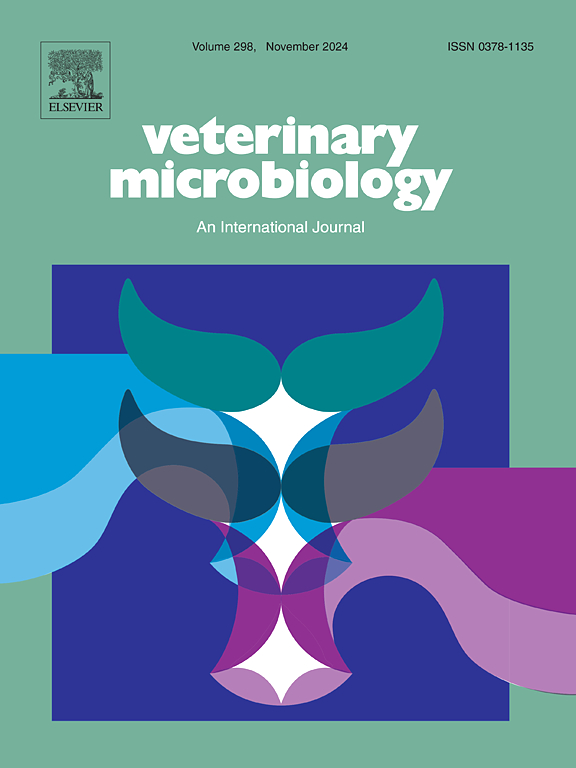智利牛呼吸道疾病和牛乳腺炎分离的牛支原体的遗传多样性。
IF 2.7
2区 农林科学
Q3 MICROBIOLOGY
引用次数: 0
摘要
牛支原体是牛的一种主要细菌病原体,可导致肺炎、乳腺炎、中耳炎和关节炎等疾病,导致重大经济损失和动物福利问题。尽管它在全球广泛分布,但在南美洲的信息有限。据报道,牛分枝杆菌是智利的一种乳腺炎病原体,但其遗传多样性尚不清楚。因此,本研究旨在确定近20年来智利奶牛(来自牛呼吸道疾病和乳腺炎病例)分离的牛分枝杆菌的遗传多样性,并利用全基因组测序方法评估它们与不同国家分离的菌株的遗传相关性。智利的牛分枝杆菌种群具有高度同质性,MLST和系统基因组分析确定ST60为优势克隆,代表了大多数分离株(97.8 %),而只有一个分离株被分型为ST12(2.2 %)。系统基因组学分析显示,大多数智利分离株遗传亲缘关系密切,与北美菌株亲缘关系密切,与加拿大ST60菌株形成紧密分支,而智利分离株ST12与北美、以色列和欧洲菌株聚类,与该物种的型菌株(PG45)聚类。此外,泛基因组分析证实,牛分枝杆菌具有一个开放的泛基因组,其大量的附属基因在很大程度上仍未被探索,可能对其基因组可塑性有关键的见解,从而为未来的研究开辟了空间。本研究的发现首次提供了对智利牛分枝杆菌种群结构的见解,有助于以南美洲为重点的该病原体的全球流行病学研究。这些结果也开启了未来研究的重点,即全面表征这一优势克隆,激励科学界进一步探索智利牛支原体的遗传多样性。本文章由计算机程序翻译,如有差异,请以英文原文为准。
Genetic diversity of Mycoplasma bovis isolated from bovine respiratory disease and bovine mastitis in Chile
Mycoplasma bovis, a major bacterial pathogen for cattle, is responsible for diseases such as pneumonia, mastitis, otitis, and arthritis, leading to substantial economic losses and animal welfare concerns. Despite its wide global distribution, there is limited information in South America. M. bovis has been reported as a mastitis agent in Chile, but its genetic diversity is poorly understood. Therefore, this study aimed to determine the genetic diversity of M. bovis isolates from Chilean dairy cattle (from bovine respiratory disease and mastitis cases) in the last two decades and evaluate their genetic relatedness with strains isolated in different countries using a whole genome sequencing approach. The M. bovis population in Chile was found to be highly homogeneous, with MLST and phylogenomic analysis identifying ST60 as the dominant clone, representing most of the isolates (97.8 %), while just one isolate was typed as ST12 (2.2 %). Phylogenomic analysis revealed close genetic relatedness among most Chilean isolates, showing a close genetic relationship with North American strains, forming a tight clade with Canadian ST60 strains, while the single Chilean ST12 isolate clustered with North American, Israeli, and European strains and clustered with the type strain (PG45) of this species. Moreover, the pangenome analysis confirms that M. bovis has an open pangenome, with a large range of accessory genes that remain largely unexplored and may hold key insights into its genome plasticity, thereby opening future research. The findings of this study provide the first insights into the Chilean population structure of M. bovis, contributing to the global epidemiology of this pathogen with a focus on South America. These results also open future research focused on the comprehensive characterization of this dominant clone, inspiring the scientific community to further exploration into the genetic diversity of M. bovis in Chile.
求助全文
通过发布文献求助,成功后即可免费获取论文全文。
去求助
来源期刊

Veterinary microbiology
农林科学-兽医学
CiteScore
5.90
自引率
6.10%
发文量
221
审稿时长
52 days
期刊介绍:
Veterinary Microbiology is concerned with microbial (bacterial, fungal, viral) diseases of domesticated vertebrate animals (livestock, companion animals, fur-bearing animals, game, poultry, fish) that supply food, other useful products or companionship. In addition, Microbial diseases of wild animals living in captivity, or as members of the feral fauna will also be considered if the infections are of interest because of their interrelation with humans (zoonoses) and/or domestic animals. Studies of antimicrobial resistance are also included, provided that the results represent a substantial advance in knowledge. Authors are strongly encouraged to read - prior to submission - the Editorials (''Scope or cope'' and ''Scope or cope II'') published previously in the journal. The Editors reserve the right to suggest submission to another journal for those papers which they feel would be more appropriate for consideration by that journal.
Original research papers of high quality and novelty on aspects of control, host response, molecular biology, pathogenesis, prevention, and treatment of microbial diseases of animals are published. Papers dealing primarily with immunology, epidemiology, molecular biology and antiviral or microbial agents will only be considered if they demonstrate a clear impact on a disease. Papers focusing solely on diagnostic techniques (such as another PCR protocol or ELISA) will not be published - focus should be on a microorganism and not on a particular technique. Papers only reporting microbial sequences, transcriptomics data, or proteomics data will not be considered unless the results represent a substantial advance in knowledge.
Drug trial papers will be considered if they have general application or significance. Papers on the identification of microorganisms will also be considered, but detailed taxonomic studies do not fall within the scope of the journal. Case reports will not be published, unless they have general application or contain novel aspects. Papers of geographically limited interest, which repeat what had been established elsewhere will not be considered. The readership of the journal is global.
 求助内容:
求助内容: 应助结果提醒方式:
应助结果提醒方式:


